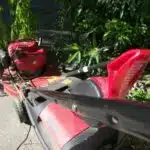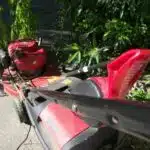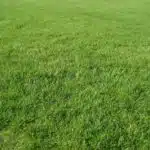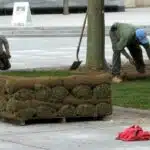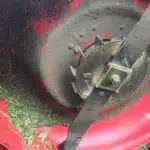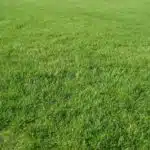As certified turfgrass management professionals, we understand the importance of maintaining a healthy and lush lawn. One crucial aspect of lawn care is core aeration, a process that involves removing small cores of soil from your lawn to promote better air and water circulation in the root zone. Core aeration is an essential part of any comprehensive lawn care program, and neglecting it can lead to poor soil health, weak root systems, and unsightly patches on your lawn.
Core aeration has numerous benefits for your lawn, including improved nutrient uptake, reduced soil compaction, increased drought tolerance, and enhanced overall health. In this article, we will delve into what core aeration is and why it is essential for maintaining a thriving lawn. We will also explore the different types of equipment used for core aeration and provide tips for performing this task effectively. As certified turfgrass management professionals, our goal is to empower you with the knowledge and tools needed to create beautiful lawns that enhance the curb appeal of your property while providing countless benefits to the environment.
The Benefits Of Lawn Care
How important is lawn care to you? Have you ever taken the time to think about the benefits of proper lawn care? As a certified turfgrass management professional, I can assure you that maintaining your lawn has more benefits than just making it look good. Proper watering techniques and fertilizer application are essential components of lawn care that can lead to healthier turfgrass.
Watering your lawn correctly can significantly impact its overall health. Overwatering or underwatering can cause damage to your grass, leaving it susceptible to diseases and pests. Finding the right balance is crucial for maintaining a healthy and vibrant lawn. Additionally, proper fertilization is key in keeping your grass green and lush. Fertilizer application provides essential nutrients that allow the grass to grow stronger, making it more resistant to disease and pests.
Incorporating good lawn care practices not only leads to a beautiful outdoor space but also contributes positively to soil health and root systems. Healthy soil supports strong root systems which help in water absorption and retention, providing nutrients necessary for growth. By enhancing soil health through core aeration, you can improve the efficiency with which your lawn uses water and nutrients while promoting robust root growth.
Soil Health And Root Systems
The Benefits of Lawn Care are numerous and well-documented. Healthy lawns not only add aesthetic value to a property, but they also provide environmental benefits such as oxygen production, carbon sequestration, and water filtration. However, achieving a healthy lawn requires more than just mowing and watering regularly. Proper soil health is essential for optimal turf growth.
Soil composition plays a crucial role in the health of grass roots. The ideal soil for growing turfgrass should be composed of 50% solids, 25% water, and 25% air. Soil compaction reduces the amount of air space between soil particles, making it difficult for roots to absorb nutrients and water from the soil. Compacted soils can also lead to poor drainage, which can result in standing water that can drown roots.
Nutrient absorption is another critical factor in maintaining healthy grass. Grass needs nutrients such as nitrogen, phosphorus, and potassium to grow correctly. However, compacted soils reduce nutrient uptake by grass roots. Aeration helps break up compacted soils and allows nutrients to reach the root zone more effectively. As a result, core aeration is an essential management practice that promotes healthy turf growth by improving soil structure and nutrient absorption.
What is Core Aeration? Core aeration is the process of mechanically removing small plugs or cores of soil from your lawn using an aerator machine. These cores are typically one-half inch in diameter and two to three inches deep. The process creates channels in the soil that allow air, water, and nutrients to penetrate deeper into the root system. Core aeration also breaks up compacted soils allowing better root development while reducing thatch buildup on top of the lawn surface.
What Is Core Aeration?
A golf course superintendent noticed that the greens on his course were not performing as well as they should be. After analyzing the soil, he determined that it was too compacted, which was limiting root growth and water infiltration. To solve this issue, he decided to implement core aeration.
Benefits of Core Aeration:
- Reduces soil compaction
- Enhances water infiltration
- Promotes root growth
Core aeration is a process where small plugs of soil and thatch are removed from the turfgrass. This allows for air, water, and nutrients to penetrate deeper into the soil profile, promoting healthier root growth. The benefits of core aeration are numerous and include reduced soil compaction, enhanced water infiltration, and improved nutrient uptake by the turfgrass roots.
The process of core aeration involves first selecting the appropriate equipment for the job. A variety of machines can be used for core aeration depending on the size of the area being treated. Typically, small areas can be done with handheld tools while larger areas may require tractor-mounted equipment. Once the equipment has been selected, it is important to properly prepare the site by marking any obstacles or hazards to avoid damaging them during aeration. Finally, once everything is ready to go, the machine is run over the target area in a pattern designed to ensure complete coverage without overlapping or missing any spots.
The Process Of Core Aeration
Before beginning the process of core aeration, it is important to mow the lawn to the recommended height for the type of turfgrass.
Core aeration involves removing plugs or cores of soil from the lawn and depositing them onto the surface.
The procedure of core aeration can be done using a hand aerator, a walk-behind aerator, or a towed aerator depending upon the size of the lawn.
Core aeration helps alleviate soil compaction, improves drainage, and increases air exchange, which are all important for healthy turfgrass growth.
Preparing The Lawn
A well-manicured lawn is a sight to behold, but achieving one requires dedication and effort. To prepare the lawn for core aeration, it’s important to properly fertilize and weed control techniques. Lawn fertilization involves applying nutrients to the soil to encourage healthy growth. Nitrogen, phosphorus, and potassium are essential elements that promote root development, color, and disease resistance. However, over-fertilizing can lead to excessive growth, which may require more frequent mowing and increase susceptibility to pests.
Weed control techniques prevent unwanted plants from competing with grass for nutrients and water. Pre-emergent herbicides are applied before weed seeds germinate while post-emergent herbicides kill existing weeds. Spot-treatment is recommended instead of blanket application as it reduces the amount of chemical used on the lawn. It’s also crucial to read labels carefully before applying any chemicals or consult a turfgrass management professional.
Preparing the lawn for core aeration sets the stage for healthy grass growth by creating channels in compacted soil that allow air, water, and nutrients to reach roots. Aeration should be done when the grass is actively growing in spring or fall so that it has time to recover before winter dormancy or summer heat stress. Following core aeration, it’s recommended to overseed thin areas of the lawn with appropriate grass species and keep the soil moist until germination occurs.
In conclusion, preparing the lawn for core aeration involves proper fertilization and weed control techniques to ensure optimal grass health. Aeration breaks up compacted soil allowing air, water, and nutrients access to grass roots resulting in improved overall health of your lawn. With these steps in mind, you’ll be on your way towards achieving a lush green carpet of grass that will be envy-worthy!
Aeration Procedure
As a certified turfgrass management professional, it’s important to understand the aeration procedure when preparing a lawn for core aeration. Aeration is the process of removing small cores of soil from the lawn, creating channels that allow air, water, and nutrients to penetrate deep into the soil and reach the grass root systems. This procedure is beneficial in reducing soil compaction and promoting healthy growth of grass.
To begin the aeration process, it’s essential to mow the lawn at least one day before. This ensures that the removed soil will not obstruct mower blades during subsequent mowings. Then, using an aerator machine with hollow tines or spikes, remove small plugs of soil from the lawn at regular intervals. The plugs should be approximately 2-3 inches apart and 2-3 inches deep to ensure optimal results.
After completing the aeration process, it’s crucial to follow up by spreading compost or topsoil over the lawn surface in order to fill in any remaining holes left by removed soil cores. This helps create an even surface while also providing additional nutrients for grass growth. With consistent application every two to three years, this procedure can significantly improve overall health and appearance of lawns while giving them deeper root systems necessary for thriving in harsh weather conditions.
Equipment For Core Aeration
Types of equipment used for core aeration depend on the size of the lawn and the level of maintenance required. A manual aerator is suitable for small lawns, whereas larger lawns require motorized equipment such as a walk-behind aerator or a tow-behind unit. The walk-behind aerator is ideal for lawns up to 1 acre, while the tow-behind unit can cover up to 3 acres.
Maintenance tips are essential to ensure that the equipment performs optimally. Before using the equipment, inspect it thoroughly for any damage or worn parts. Ensure that all nuts and bolts are tightened before starting the machine. Grease any moving parts where necessary, and check oil levels regularly as specified by the manufacturer.
Choosing the right time for core aeration is crucial in achieving optimal results. It is best done during active growth periods when turfgrass plants recover quickly from soil disruption. In cool-season grasses like Kentucky bluegrass and fescue, early fall or spring is ideal. For warm-season grasses like Bermuda grass and Zoysia grass, late spring to early summer is recommended. By choosing the right time, you can ensure that your lawn will be healthy and lush throughout the growing season.
Choosing The Right Time For Core Aeration
When it comes to core aeration, timing is everything. Choosing the right time can make all the difference in achieving optimal results. But what are the best seasons for core aeration? And what are the optimal conditions for this process?
In general, the best time to aerate your lawn is during its growing season. For warm-season grasses like Bermuda and Zoysia, this means late spring or early summer. For cool-season grasses like Kentucky bluegrass and fescue, early fall is generally preferred. This timing allows new growth to fill in any holes left by the plugs removed during aeration.
In addition to timing, optimal conditions should be considered before beginning aeration. The soil should be moist but not waterlogged, as overly wet soil can cause damage to both your lawn and equipment. If you’re unsure about whether or not it’s safe to aerate your lawn due to recent rainfall or watering habits, use a screwdriver or other long tool to test moisture levels before proceeding.
Now that we’ve discussed choosing the right time and conditions for core aeration, let’s move on to another important question: how often should I core aerate my lawn?
How Often Should I Core Aerate My Lawn?
Core aeration is a process that involves mechanically removing small plugs of soil from the lawn in order to reduce soil compaction, improve water and nutrient uptake, and reduce thatch buildup. Aeration should be performed at least once a year, depending on factors such as soil type, turfgrass species, and turfgrass health. The primary benefit of aeration is that it improves root growth and vigor of the turfgrass, leading to a healthier and more attractive lawn. Core aeration can be done manually with a hand-held aerator, or mechanically with a tractor-mounted aerator. Additionally, liquid aeration is a chemical-free, environmentally friendly option for lawn aeration. Finally, mechanical aeration should be followed immediately by overseeding for best results.
Frequency Of Aeration
As a certified turfgrass management professional, I highly recommend core aeration as an essential practice in maintaining a healthy lawn. However, the frequency of aeration depends on various factors such as soil type, grass species, and the amount of foot traffic. Optimal timing for aeration is during the growing season when the grass has enough time to recover from any damage.
The frequency of aeration is determined by the compaction level of the soil. The more compacted the soil is, the more frequently it needs to be aerated. If your lawn receives high foot traffic or heavy machinery use, then you should aerate it annually or bi-annually. On the other hand, if your lawn has loose soil and minimal foot traffic, then once every three years would suffice.
Optimal timing for aeration is during periods of active growth when grass can quickly recover from any stress caused by coring. For warm-season grasses like Bermuda or Zoysia grass, early summer is ideal for aerating. Cool-season grasses like Kentucky bluegrass or perennial ryegrass should be aerated in spring or fall when temperatures are mild and there’s enough moisture in the soil to facilitate root growth. In conclusion, proper aeration frequency and optimal timing are crucial factors that determine how successful your lawn maintenance efforts will be.
Benefits Of Aeration
Core aeration is an essential practice in maintaining a healthy lawn. One of the benefits of aeration is improving drainage, which allows water and nutrients to penetrate deeper into the soil, promoting healthier root growth. Another benefit is reducing soil compaction, which can improve air circulation and help prevent common lawn problems such as thatch buildup or fungal diseases. Aeration also helps break down organic matter and promote microbial activity in the soil, leading to a healthier ecosystem for your lawn.
Regularly aerating your lawn can provide numerous benefits that will enhance its overall health and appearance. By improving drainage and reducing soil compaction, you can help ensure that your grass receives the necessary resources it needs to thrive. Additionally, by breaking down organic matter and promoting microbial activity in the soil, you can create a more sustainable environment that will lead to long-term success.
If you are looking to improve the health of your lawn, consider incorporating core aeration into your maintenance routine. By doing so regularly, you can enjoy all the benefits mentioned above while preventing potential issues from arising in the future. Remember to adjust the frequency of aeration based on factors such as soil type and foot traffic levels to ensure optimal results.
Aeration Methods
As a certified turfgrass management professional, it is crucial to understand the different aeration methods available when considering how often to core aerate your lawn. Two common methods are plug and spike aeration, which can be performed manually or mechanically. Plug aeration involves removing small plugs of soil from the lawn, while spike aeration involves puncturing the soil with solid tines.
Manual plug aeration can be time-consuming and physically demanding, but it allows for more precise control over the depth and spacing of holes. On the other hand, mechanical plug aerators can cover larger areas quickly but may not provide as consistent hole spacing. Spike aerators are typically less expensive and easier to use than plug aerators but can actually increase soil compaction if used frequently or in heavy clay soils.
When deciding how often to core aerate your lawn, consider factors such as soil type and foot traffic levels in addition to the chosen method of aeration. For example, heavily trafficked lawns may need more frequent core aeration than those with minimal foot traffic. Additionally, manual plug aeration may be more beneficial for compacted clay soils compared to mechanical spike aeration which could cause further compaction.
In summary, understanding the pros and cons of each method of core aeration can help determine how often you should perform this essential practice on your lawn. Factors such as soil type and foot traffic levels should also be taken into account when making this decision. Consulting with an experienced turfgrass management professional or performing regular soil tests can help ensure that you are providing optimal care for your lawn.
Preparing Your Lawn For Core Aeration
After determining the frequency of core aeration for your lawn, the next step is to prepare it for the process. Before performing core aeration, it is essential to conduct a lawn analysis to determine its soil type, pH level, and nutrient content. Lawn analysis will provide information on how much fertilizer and other supplements may be required to enrich the soil’s nutrients and improve its overall health.
Weed control is also an essential aspect of preparing your lawn for core aeration. Weeds compete with grass for nutrients and water, making them difficult to eliminate once they have taken hold in your yard. Before performing core aeration, ensure that all weeds are removed or treated with appropriate weed killers. This way, you can focus on improving the soil’s condition without worrying about competing plants.
Performing core aeration effectively is crucial in ensuring that it yields optimal results for your lawn. To achieve this, it is recommended that you hire a professional turfgrass management expert who understands what it takes to perform the process effectively. They will help you identify any underlying issues in your soil and recommend appropriate solutions to remedy them while also ensuring that no damage is done to your yard during the core aeration process.
Transition: Now that we know how to prepare our lawns for core aeration let us explore some tips on performing this procedure effectively.
Performing Core Aeration Effectively
Performing core aeration is not just a matter of poking holes in the ground. It requires a great deal of skill and knowledge to execute effectively. To begin, you will need certain tools to perform the task correctly. These tools include an aerator machine, which can be rented or purchased, and other equipment such as gloves and safety goggles.
One common mistake that people make when performing core aeration is not using the right equipment for their specific lawn needs. For example, if your lawn has a lot of rocks or debris, you will need an aerator with larger tines that can handle these obstacles. Another common error is not using enough passes over the lawn to ensure that all areas are thoroughly aerated.
In addition to understanding what tools are needed and avoiding common mistakes, it’s important to know how to care for your lawn after core aeration. This will help ensure that the process was effective in promoting healthy growth for your grass. The next section will cover post-aeration lawn care in detail, including tips on watering, fertilizing, and mowing your lawn after the aeration process is complete.
Post-Aeration Lawn Care
Having successfully performed core aeration on your lawn, it is essential to follow up with proper post-aeration care. Post-aeration overseeding is an effective way to fill in any bare or thin patches in your lawn. Overseeding involves spreading grass seed over the existing turf, promoting thicker and healthier grass growth.
Another crucial aspect of post-aeration lawn care is nutrient application. Aerate lawns tend to absorb nutrients more efficiently since the soil is loosened up, making it easier for water and nutrients to penetrate the roots. Applying a fertilizer high in nitrogen after aeration can help boost grass growth and improve overall lawn health.
Incorporating post-aeration overseeding and nutrient application into your lawn care routine can significantly enhance the results of core aeration. Neglecting these vital steps could lead to subpar results that are less than desirable. In the next section, we will take a look at some common mistakes to avoid when performing core aeration on your lawn.
Common Mistakes To Avoid
Core aeration is an important part of a healthy turfgrass management program. Avoiding not aerating enough is a common mistake that can lead to soil compaction, poor drainage, and reduced oxygen levels. Over-aerating can also be a mistake, as it can weaken the root system, inhibit microbial activity, and lead to increased thatch levels. To ensure optimal turfgrass health, it is best to aerate within the recommended frequency and depth guidelines.
Not Aerating Enough
A lush, green lawn is the dream of every homeowner. However, achieving this requires some work and care. One of the essential maintenance practices for a healthy lawn is core aeration. Nonetheless, many people make the mistake of not aerating enough. Failure to aerate leads to soil compaction, which can negatively affect the growth and health of your grass.
As a certified turfgrass management professional, I understand the benefits of aerating your lawn. Core aeration involves removing small plugs of soil from your lawn to alleviate soil compaction and promote root growth. This process allows air, water, and nutrients to penetrate deeper into the soil and reach the grass roots, facilitating better nutrient uptake and promoting healthy growth.
Unfortunately, many homeowners overlook core aeration or don’t do it frequently enough. Soil becomes compacted over time due to factors like foot traffic or heavy equipment use on lawns. Without proper aeration, roots struggle to grow deep enough into the soil for adequate water and nutrient absorption. Therefore, it is vital to avoid this common mistake by scheduling regular core aeration sessions with an expert in turfgrass management or investing in professional-grade equipment for home use.
In conclusion, neglecting core aeration can impede your efforts towards achieving a lush green lawn that will amaze your neighbors or guests. Properly maintained turfgrass contributes significantly to property value as well as environmental sustainability by reducing erosion and promoting cleaner air quality through photosynthesis. Avoiding common mistakes like not aerating enough helps ensure that you achieve these benefits while keeping your yard looking healthy year-round.
Over-Aerating
Core aeration is an essential lawn maintenance practice that promotes deep root growth and healthy grass. However, while many homeowners overlook this process, others make the mistake of over-aerating their lawns. This error can be equally detrimental to your grass and should be avoided at all costs. Over-aerating occurs when a lawn is aerated more frequently than is necessary or when too many holes are punched into the soil.
Avoiding over-aerating is crucial because it can cause significant damage to your lawn. One sign of over-aeration is thatch accumulation. Thatch buildup happens when too many small plugs of soil are removed from the ground, causing the dead plant material to accumulate on top of the remaining soil. Additionally, over-aeration can lead to dehydration since moisture can evaporate faster through the increased number of holes in the ground. If you notice these signs or other unusual changes in your lawn after core aeration, it’s time to reduce its frequency.
Lastly, it’s important to note that avoiding over-aeration doesn’t mean neglecting core aeration altogether. Instead, it means understanding how often your lawn needs this treatment and sticking to a schedule for optimal results. A certified turfgrass management professional can assess your lawn’s needs and recommend an appropriate core aeration schedule based on factors such as soil type, climate conditions, and foot traffic levels. By avoiding common mistakes like over-aerating, you’ll ensure that your lawn remains healthy and vibrant for years to come.
Diy Vs. Professional Core Aeration
As with any other household maintenance task, homeowners can opt to perform core aeration themselves or hire a professional service. While DIY aeration may seem like an economical and easy solution, it comes with its own set of challenges. Proper equipment is needed for the job, including an aerator machine which could cost hundreds of dollars to rent or buy. Additionally, knowing when and how to properly aerate your lawn can be difficult without adequate knowledge in turfgrass management.
On the other hand, hiring a professional service brings numerous benefits that DIY aeration simply cannot match. Certified turfgrass management professionals use specialized equipment and techniques to ensure optimal results. They also possess expert knowledge on soil composition, grass type, and weather conditions which play crucial roles in determining the ideal time for core aeration. By leaving this task in the hands of professionals, homeowners can rest easy knowing their lawns are in capable hands.
While there are certainly challenges associated with DIY core aeration, it’s important to weigh up both options before making a decision. Homeowners who are confident in their abilities and have access to proper equipment may choose to go down the DIY route. However, for those who prioritize optimal lawn health and don’t mind spending extra money, hiring a professional service is likely the best option. Ultimately, whichever choice you make, keeping your lawn healthy through regular core aeration will pay dividends in terms of overall appearance and longevity. With that being said, let’s explore cost considerations when it comes to core aeration services.
Cost Considerations
Core aeration is a process by which a core of soil is removed from the lawn to improve its quality and health. The cost consideration for core aeration includes the cost of the equipment involved in the process, the labor costs associated with the aeration, and the cost of improving the soil quality. The cost of the equipment required to perform core aeration is dependent on the type of machine and its size. Labor costs for core aeration are typically calculated based on the size of the lawn and the complexity of the job. Soil quality costs include the cost of fertilizers, soil amendments, and other materials needed to restore the natural soil structure of the lawn after core aeration.
Cost Of Equipment
Core aeration is an essential practice for maintaining a healthy lawn. However, before starting the process, it is crucial to consider the cost of equipment. The cost of equipment can significantly affect the overall budget of core aeration. A certified turfgrass management professional should be aware of the available options and make informed decisions to ensure that clients get the best value for their money.
Equipment cost is one of the most significant expenses associated with core aeration. The cost varies depending on factors such as size, power, and features. While purchasing equipment may seem like the best option, renting is often more economical, especially for small-scale projects. Rental options provide access to high-quality equipment without incurring high costs.
When considering the cost of equipment for core aeration, it is important to note that rental options offer several advantages over purchasing. Apart from lower costs, rental options provide flexibility in terms of equipment selection and maintenance. Rental companies also offer training on how to use the equipment correctly, ensuring that clients achieve optimal results. In summary, understanding rental options can help certified turfgrass management professionals make informed decisions about equipment costs while ensuring customer satisfaction.
Labor Costs
Cost benefit analysis is an essential aspect of core aeration, and certified turfgrass management professionals must consider all expenses associated with the process. One significant cost consideration is labor costs. While equipment rental is an affordable option, the cost of hiring labor can significantly impact overall expenses.
Labor costs vary depending on factors such as the size of the lawn, the complexity of the project, and the hourly rates charged by laborers. Certified turfgrass management professionals should carefully evaluate these factors before commencing any core aeration project. They should also make informed decisions about whether to hire permanent or temporary laborers and ensure that they comply with all relevant labor laws.
While labor costs can be a significant expense, there are several ways to minimize them. For example, it may be possible to negotiate lower rates with laborers or hire them for off-peak periods when demand is lower. Additionally, certified turfgrass management professionals can also invest in training their employees to ensure they work efficiently and effectively, thus reducing the time required for each project. By exploring these options, professionals can keep their costs under control while still providing high-quality services to their clients.
Soil Quality Costs
As certified turfgrass management professionals, we must consider all expenses associated with core aeration to provide high-quality services while keeping costs under control. One significant cost consideration is soil quality costs. Soil quality plays a crucial role in the success of any core aeration project, and it’s essential to evaluate the condition of soil before commencing any work. Poor soil quality can lead to negative impacts on turf growth, which can result in increased maintenance expenses over time.
To minimize soil quality costs, we must invest in regular testing and analysis to determine the specific needs of each lawn. The test results can help us determine the best course of action for improving soil quality and what amendments are necessary for optimal growth. Some factors that impact soil quality include pH levels, nutrient deficiencies, organic matter content, compaction issues, and more. Addressing these issues through soil amendment can result in healthier turf that requires less maintenance over time.
Additionally, investing in preventative measures like regular fertilization and proper irrigation can also contribute to improved soil health. By providing consistent care for lawns throughout the year, we can reduce the likelihood of costly repairs or significant renovations down the line. Ultimately, by prioritizing soil health as a critical cost consideration during core aeration projects, we can provide better services to our clients while maintaining profitability as certified turfgrass management professionals.
Troubleshooting Common Issues
As with any lawn care technique, core aeration can come with its own set of issues that may arise. Fortunately, there are effective techniques and troubleshooting tips that can help to avoid or resolve these common problems. Some of the most common issues include soil compaction, uneven aeration, ineffective soil penetration, and improper timing.
One of the most important factors in successful core aeration is ensuring proper soil penetration. If the aerator does not penetrate deeply enough into the soil, it will not be able to effectively pull out plugs. To avoid this issue, it is important to choose an aerator with tines that are long enough for your specific soil type and condition.
Another problem that can arise during core aeration is unevenness in the depth of the holes left behind by the plugs. This can be caused by a number of factors including uneven ground level or varying soil types within the lawn. To prevent this issue, it may be helpful to use an aerator with adjustable tine depth or to go over areas multiple times at different angles.
- Troubleshooting Tips:
- Monitor moisture levels prior to and during core aeration.
- Adjust tine depth based on specific soil type and condition.
- Plan core aeration around peak growing seasons for optimal results.
- Address any underlying issues such as drainage problems before performing core aeration.
- Regularly maintain and sharpen aerator tines to ensure effectiveness.
In summary, while core aeration can be an effective tool for promoting healthy lawns, it is important to take steps to avoid common pitfalls. By following these troubleshooting tips and using appropriate techniques for your lawn’s unique needs, you can ensure success with this valuable lawn care practice. In the future of lawn care, sustainability and innovation will continue to play key roles in developing even more effective methods for maintaining beautiful lawns while minimizing environmental impact.
The Future Of Lawn Care: Sustainability And Innovation
Lawn technology has undergone significant advancements in recent years, with sustainability and innovation at the forefront of these developments. These advancements have come as a response to concerns regarding the environmental impact of traditional lawn care practices. The future of lawn care is set to be shaped by environmentally conscious solutions that reduce the carbon footprint of landscaping.
One such solution is the use of robotic lawn mowers. These machines are designed to cut grass autonomously, without human intervention. They use sensors to detect obstacles and adjust their course accordingly, ensuring an even cut across the entire lawn. Robotic mowers run on rechargeable batteries and produce zero emissions, making them an eco-friendly alternative to gas-powered mowers.
Another promising development in lawn technology is the use of drought-tolerant grasses. These grasses can withstand long periods without water, reducing water usage and conserving resources. Additionally, they require less fertilizer and maintenance than traditional grass types, further reducing their environmental impact. By incorporating these varieties into their landscapes, homeowners can reduce their water bills while also helping to preserve natural resources.
Table: Benefits of Sustainable Lawn Care Practices
| Benefits | Description | Examples |
|---|---|---|
| Water conservation | Reducing water usage through efficient irrigation systems or drought-tolerant grass varieties | Installing low-flow sprinkler heads or planting Buffalo Grass |
| Reduced chemical usage | Limiting the application of pesticides and fertilizers | Using integrated pest management techniques or organic fertilizers |
| Carbon footprint reduction | Minimizing greenhouse gas emissions through eco-friendly equipment or sustainable practices | Switching from gas-powered mowers to electric models |
As we look ahead to the future of lawn care, it is clear that sustainability and innovation will continue to shape this industry. Homeowners who prioritize eco-friendly solutions can make a positive impact on their local environment while still maintaining beautiful lawns. By implementing sustainable practices and utilizing cutting-edge technology, we can ensure that our landscapes remain healthy and vibrant for years to come.
Conclusion
Maintaining a healthy lawn requires careful attention to soil health and root systems. One effective technique for promoting these factors is core aeration. This process involves removing small plugs of soil from the lawn, allowing air, water, and nutrients to penetrate deeper into the soil. Core aeration also helps break up compacted soil, improving drainage and reducing runoff.
Whether you choose to tackle core aeration as a DIY project or hire a professional, it’s important to understand the equipment involved and potential costs. By troubleshooting common issues such as uneven plug removal or damage to sprinkler heads, you can ensure that your lawn reaps the full benefits of this process.
As turfgrass management professionals look ahead to the future of lawn care, sustainability and innovation will continue to play key roles in promoting healthy lawns and landscapes. By staying up-to-date on advances in technology and techniques such as core aeration, we can help our clients achieve beautiful outdoor spaces while minimizing negative impacts on the environment.
Image Credits
- “Manual aeration of the lawn” by Vincent Ma (featured)






